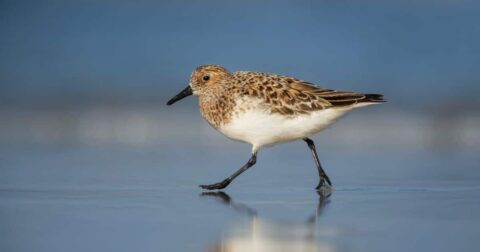Explainer
Why Eating Organic Isn’t a Climate Solution
Climate•8 min read
Analysis
The avian influenza is a growing source of concern for Latin American researchers, since its high pathogenicity represents a risk of infection for migratory shorebirds.


Words by Jorge Rodriguez
Each year, shorebirds like the Hudsonian godwit and the Whimbrel travel from Alaska to the southern tip of Chile in South America, stopping in different Latin American countries along the way. The migration of these species helps keep the marine coastal ecosystems along the route stay in ecological balance, ensuring the presence of worms, small crustaceans and other microfauna that live below the ground and are the basis of food for shorebirds. If the soil is healthy, that is good news for humans, who can carry out productive activities that benefit its sustainability.
But this year, scientists that work with this group of migratory birds are worried. An estimated 40 million birds or more have been infected by the highly pathogenic avian influenza A in the U.S. — mostly poultry, such as hens, chickens, ducks and geese — a figure more than 10 times higher than previously recorded. If migratory shorebirds contract avian flu at the start of their journey in Alaska, the disease could decimate their population numbers, not to mention the populations of other birds along the way.
Shorebirds are one of the most vulnerable bird species — habitat loss has already reduced their population rates. According to the North American Bird Conservation Initiative (NABCI), of the 49 species of migratory shorebirds currently identified, 25 show sustained declines over time. Some species such as the Ruddy turnstone and the Semipalmated sandpiper have lost up to 80 percent of their population density since 1974.
Now that the migration season is underway, avian flu may put these birds at greater risk. “The most likely thing,” according to Medardo Cruz, a Mexican biologist and researcher, is that “the virus will reach the south.”
He found possible proof of this in the Ceuta region, south of Sinaloa in Mexico, a small populated area with a shoreline to the Pacific coast, where several cases of infected waterfowl and shorebirds have already been spotted. “We have found a higher than normal number of dead Least Tern individuals,” Cruz says. The Least Tern is a small seabird that breeds in North and South America. “We saw some individuals of Snowy plover that presented some symptoms that coincide with avian flu,” he added, referring to a small, plump bird with a large head.
Migratory shorebirds have communal habits. They eat, rest and even migrate in large groups of different shorebird and waterfowl species. Those habits make disease spread more likely once there’s an outbreak. And scientists like Cruz are fearful because once scientists detect an outbreak, it probably means the number of actual infected birds is even higher.
In the U.S. and Canada, most research institutes have procedures in place to handle these situations, “they know what to do as soon the first signs of infections appear,” said Cruz. Shorebird conservation is a more recent effort in Latin America due to the lack of laboratories, low funding and the poorly supported research culture.
So researchers and conservation groups in Latin America are trying to spread the word now about what precautions to take.
For now, avian flu has not yet spread to Latin America at alarming rates. Still, outbreaks in continental birds, such as hawks, bald eagles and ravens, has raised concerns in the scientific community that shorebirds may be next. This is the first time since 2016 that so many species not typically associated with the H5N1 HPAI strain have been affected by it.
Avian researchers from Cornell suggest that anyone who works with poultry should follow biosecurity protocols when coming into contact with other birds, taking extra care to keep them isolated from contact with other wild bird populations. The USDA also recommends you remove bird feeders and waterers, as they could become a source of infection for other species.
“We have to be very careful, especially now that we know about these outbreaks. If at the time of handling them you did not follow the appropriate steps, then you can also be part of the problem,” advises Cruz.
Cruz says the COVID-19 pandemic taught them, as scientists, to be on high alert at even the slightest hint of an outbreak of any disease that endangers the lives of wildlife and human populations. Because they haven’t experienced an outbreak of avian flu in shorebirds before now, he says, “we are not sure if there are specific protocols.” But Cruz is in contact with his American colleagues to be as prepared as possible, ready, he says, for “any given situation.”